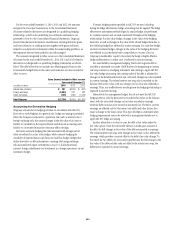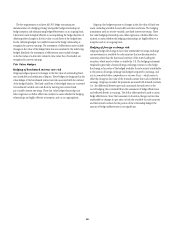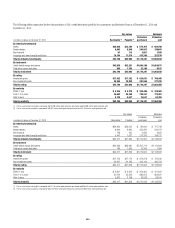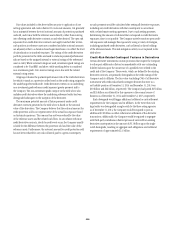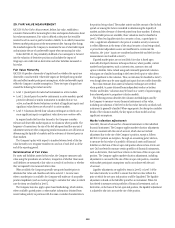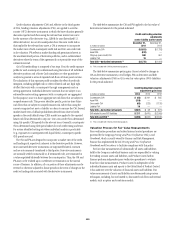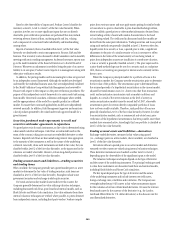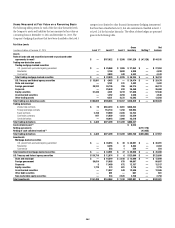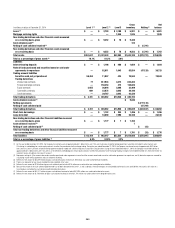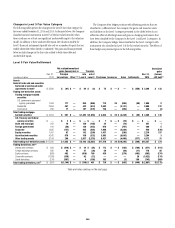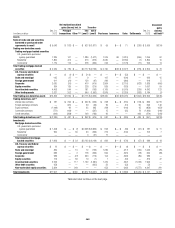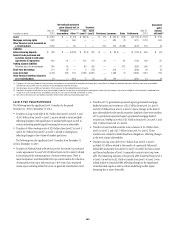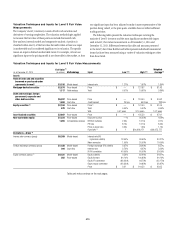Citibank 2014 Annual Report Download - page 277
Download and view the complete annual report
Please find page 277 of the 2014 Citibank annual report below. You can navigate through the pages in the report by either clicking on the pages listed below, or by using the keyword search tool below to find specific information within the annual report.260
Basedontheobservabilityofinputsused,ProductControlclassifiesthe
inventoryasLevel1,Level2orLevel3ofthefairvaluehierarchy.When
a position involves one or more significant inputs that are not directly
observable, price verification procedures are performed that may include
reviewing relevant historical data, analyzing profit and loss, valuing
each component of a structured trade individually, and benchmarking,
among others.
ReportsofinventorythatisclassifiedwithinLevel3ofthefairvalue
hierarchyaredistributedtoseniormanagementinFinance,Riskandthe
business.ThisinventoryisalsodiscussedinRiskCommitteesandinmonthly
meetings with senior trading management. As deemed necessary, reports may
gototheAuditCommitteeoftheBoardofDirectorsortothefullBoardof
Directors. Whenever an adjustment is needed to bring the price of an asset or
liability to its exit price, Product Control reports it to management along with
other price verification results.
In addition, the pricing models used in measuring fair value are governed
by an independent control framework. Although the models are developed
and tested by the individual business units, they are independently validated
bytheModelValidationGroupwithinRiskManagementandreviewedby
Finance with respect to their impact on the price verification procedures. The
purpose of this independent control framework is to assess model risk arising
from models’ theoretical soundness, calibration techniques where needed,
and the appropriateness of the model for a specific product in a defined
market. To ensure their continued applicability, models are independently
reviewedannually.Inaddition,RiskManagementapprovesandmaintains
a list of products permitted to be valued under each approved model for a
given business.
Securities purchased under agreements to resell and
securities sold under agreements to repurchase
No quoted prices exist for such instruments, so fair value is determined using
a discounted cash-flow technique. Cash flows are estimated based on the
terms of the contract, taking into account any embedded derivative or other
features. Expected cash flows are discounted using interest rates appropriate
to the maturity of the instrument as well as the nature of the underlying
collateral. Generally, when such instruments are held at fair value, they are
classifiedwithinLevel2ofthefairvaluehierarchy,astheinputsusedinthe
valuation are readily observable. However, certain long-dated positions are
classifiedwithinLevel3ofthefairvaluehierarchy.
Trading account assets and liabilities—trading securities
and trading loans
When available, the Company generally uses quoted market prices in active
markets to determine the fair value of trading securities; such items are
classifiedasLevel1ofthefairvaluehierarchy.Examplesincludesome
government securities and exchange-traded equity securities.
For bonds and secondary market loans traded over the counter, the
Company generally determines fair value utilizing valuation techniques,
including discounted cash flows, price-based and internal models, such as
Black-ScholesandMonteCarlosimulation.Fairvalueestimatesfromthese
internal valuation techniques are verified, where possible, to prices obtained
fromindependentsources,includingthird-partyvendors.Vendorscompile
prices from various sources and may apply matrix pricing for similar bonds
or loans where no price is observable. A price-based methodology utilizes,
where available, quoted prices or other market information obtained from
recent trading activity of assets with similar characteristics to the bond
or loan being valued. The yields used in discounted cash flow models are
derived from the same price information. Trading securities and loans priced
usingsuchmethodsaregenerallyclassifiedasLevel2.However,whenless
liquidity exists for a security or loan, a quoted price is stale, a significant
adjustment to the price of a similar security or loan is necessary to reflect
differences in the terms of the actual security or loan being valued, or
prices from independent sources are insufficient to corroborate valuation,
aloanorsecurityisgenerallyclassifiedasLevel3.Thepriceinputusedin
a price-based methodology may be zero for a security, such as a subprime
CDO, that is not receiving any principal or interest and is currently written
down to zero.
Where the Company’s principal market for a portfolio of loans is the
securitization market, the Company uses the securitization price to determine
the fair value of the portfolio. The securitization price is determined from
the assumed proceeds of a hypothetical securitization in the current market,
adjusted for transformation costs (i.e., direct costs other than transaction
costs) and securitization uncertainties such as market conditions and
liquidity. As a result of the severe reduction in the level of activity in
certain securitization markets since the second half of 2007, observable
securitization prices for certain directly comparable portfolios of loans
have not been readily available. Therefore, such portfolios of loans are
generallyclassifiedasLevel3ofthefairvaluehierarchy.However,forother
loan securitization markets, such as commercial real estate loans, price
verification of the hypothetical securitizations has been possible, since these
markets have remained active. Accordingly, this loan portfolio is classified as
Level2ofthefairvaluehierarchy.
Trading account assets and liabilities—derivatives
Exchange-traded derivatives, measured at fair value using quoted
(i.e., exchange) prices in active markets, where available, are classified as
Level1ofthefairvaluehierarchy.
Derivatives without a quoted price in an active market and derivatives
executed over the counter are valued using internal valuation techniques.
ThesederivativeinstrumentsareclassifiedaseitherLevel2orLevel3
depending upon the observability of the significant inputs to the model.
The valuation techniques and inputs depend on the type of derivative
and the nature of the underlying instrument. The principal techniques used
to value these instruments are discounted cash flows and internal models,
includingBlack-ScholesandMonteCarlosimulation.
The key inputs depend upon the type of derivative and the nature
of the underlying instrument and include interest rate yield curves,
foreign-exchange rates, volatilities and correlation. The Company uses
overnight indexed swap (OIS) curves as fair value measurement inputs
for the valuation of certain collateralized derivatives. Citi uses the relevant
benchmarkcurveforthecurrencyofthederivative(e.g.,theLondon
InterbankOfferedRateforU.S.dollarderivatives)asthediscountratefor
uncollateralized derivatives.


